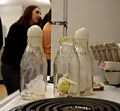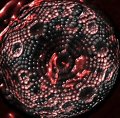 Ever fancied squeezing an egg into a bottle? No? Well, it’s a kind of perennial physics demonstration that science teachers the world over love to do. I could simply describe how to do it and the results you might expect, but that would be no fun at all. Instead, I spent a good ten minutes scanning videos on the net where individuals attempted to carry out this experiment, some of them more successfully than others. Most handling naked flames and solvents (methylated spirits and the like) in a non-laboratory setting with absolutely no safety equipment (not even goggles) in sight.
Ever fancied squeezing an egg into a bottle? No? Well, it’s a kind of perennial physics demonstration that science teachers the world over love to do. I could simply describe how to do it and the results you might expect, but that would be no fun at all. Instead, I spent a good ten minutes scanning videos on the net where individuals attempted to carry out this experiment, some of them more successfully than others. Most handling naked flames and solvents (methylated spirits and the like) in a non-laboratory setting with absolutely no safety equipment (not even goggles) in sight.
More importantly though, most of these experimenters managed to get most of the egg in the bottle, but usually the egg split and simply splurted into the bottle rather than squeezing through the neck and plopping into the bottle intact.
In this video, the “researchers” succeeded in getting a nice squeeze and plop (far better even than the Brainiac team in their attempt).
The key to their success is apparently using a bottle with a nice wide neck. Most of the other videos try to use a beer bottle or something similar which constricts the egg as it squeezes through the opening and splits it.
So, how does it work? What mysterious force is pulling the egg into the bottle? Well, the answer is there is no mystery it is simply air pressure pushing down on the egg. But, wait a minute, what’s the burning paper got to do with air pressure?
Okay, here’s the short of it. Dropping a burning spill (or burning piece of paper into a bottle) and the air in the bottle will quickly expand and a small volume escapes. When the hard-boiled egg (with the shell removed) is placed into the opening, the spill goes out, the remaining gas cools and contracts and the greater outside air pressure pushes the moist flexible egg into the hole nicely.
If you use a nice moist egg and a bottle with a wide enough neck you’ll get a nice squeeze and plop. Anyone who has a use for a hard-boiled egg covered in burnt paper stuck in a bottle is welcome to contact us at Sciencebase with their ideas. Additionally, if you know how to get the egg out again without breaking the bottle leave us you thoughts in the comment form.
 Light-emitting diodes almost ubiquitously provide the illumination in electronics and potentially will provide energy-efficient brightness in our homes. However, the LED material of choice, gallium nitride, and its method of processing and manufacture into working devices is relatively expensive. Now, US engineers have developed a novel semiconducting material based on zinc oxide that could be used in a new type of LED that is just as effective but could reduce costs for a wide range of applications.
Light-emitting diodes almost ubiquitously provide the illumination in electronics and potentially will provide energy-efficient brightness in our homes. However, the LED material of choice, gallium nitride, and its method of processing and manufacture into working devices is relatively expensive. Now, US engineers have developed a novel semiconducting material based on zinc oxide that could be used in a new type of LED that is just as effective but could reduce costs for a wide range of applications. Regular readers will recall my mention of the
Regular readers will recall my mention of the  Over at the American Institute of Physics my colleague Phillip Schewe and his team have been putting together their pick of the physics discoveries for 2006.
Over at the American Institute of Physics my colleague Phillip Schewe and his team have been putting together their pick of the physics discoveries for 2006. The classic fish-eye lens gives photographers the visual equivalent of surround sound, capturing an all-encompassing view. But, while the results are dramatic the subject is considerably distorted to fit within the bounds of the circular image formed. This renders such lens ineffective as an all-seeing-eye in a security setting or for providing robots with better navigation.
The classic fish-eye lens gives photographers the visual equivalent of surround sound, capturing an all-encompassing view. But, while the results are dramatic the subject is considerably distorted to fit within the bounds of the circular image formed. This renders such lens ineffective as an all-seeing-eye in a security setting or for providing robots with better navigation.